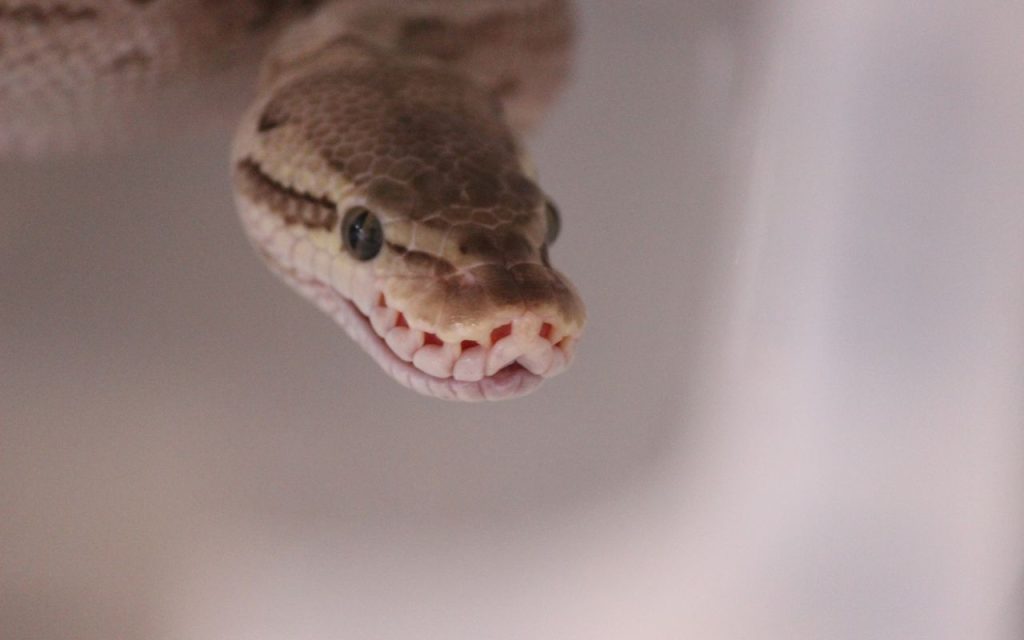Ball Python mouth rot is a type of oral infection, and quite possibly the most disturbing condition you could witness with this species. In advance cases, the whole mouth and neck will become completely bloated, and deep dissue damage will degrade the buccal cavity. Within weeks – or sometimes just days – the snake will die from sepsis.
Fortunately, being such a dramatic illness, mouth rot causes some clear symptoms that you can pick up on. It’s also reasonably treatable, if you can find a good exotics vet. In this post, I’m going to tell you how to recognise, treat, and prevent mouth rot…
What is mouth rot?
Often referred to as ulcerative stomatitis or infectious stomatitis, mouth rot is an inflammatory condition that affects the oral cavity. Many of you will be familiar with stomatitis in birds, turtles, and even humans, where it is most commonly caused by vitamin deficiencies or malocclusion (the teeth, beak, or jaws not meeting correctly).
In snakes, mouth rot is a little different. It only rarely relates to a vitamin deficiency. Rather, it’s something you usually see in snakes that have been kept in unsanitary conditions or suffered an injury.
While it might sound simple, untreated mouth rot can lead to severe complications. Think of it as similar to a gum disease in humans, but more visually alarming and more likely to spread. Left untreated, it will quickly eat its way into the maxillary bones, dentary bones, glottis, and even trachea.
When compared to scale rot, or necrotic dermatitis, it’s important to remember that mouth rot is generally faster spreading – making it even more urgent to deal with.
Signs of Mouth Rot in Snakes
Some of the symptoms of stomatitis are similar to those of a respiratory infection. That is to say open mouthed breathing, wheezing, bubbling, excessive salivation, and clicking. Often, the first thing you’ll notice is that your snake seems unable to completely close its mouth.
To determine which condition you’re seeing, a look inside the mouth will be necessary. If you aren’t experienced doing this kind of thing, it really is best to book an appointment with a vet and let them do it. After all, there’s nothing pythons hate more than someone trying to open their mouth.
During oral examination, symptoms of mouth rot include:
- Yellowish or whitish substance lining the snake’s mouth. This is usually in clumps that appear stuck in place.
- Red and inflamed oral tissue, often with tiny bleeds.
- Swelling around the jaw area.
- Swelling of the rostrum (snout)
- Discharge or pus from the mouth.

Causes of Mouth Rot
Upon investigation, the vast majority of cases involve infection from bacteria such as those in the Enterobacter group. Often, there is also co-infection with fungal agents like Aspergillus. As with most diseases of captive animals, however, it starts with an underlying cause.
The underlying causes can range from simple factors like unclean habitats to deeper underlying health issues. Here are a few:
- Poor Hygiene: An unclean terrarium is a breeding ground for bacteria.
- Physical Trauma: Any injury to the mouth can get infected if not treated.
- Stress: A stressed snake is prone to various health problems, including mouth rot.
- Improper Diet: Feeding a snake inappropriate or contaminated food can contribute to the condition.
Now, I’ve listed every possible cause here, but in my experience, 99.99% of cases arise from poor hygiene or physical trauma. If a snake lives in a dirty enclosure, it will eventually catch something – it’s literally just a matter of time. Add in a little injury from rubbing its nose against a rough ornament or a missed strike that cuts its gum, and hey presto: You’ve got a case of mouth rot.
Preventing the Condition
The best approach to preventing mouth rot is a holistic approach. Make sure every single aspect of your snake’s husbandry is great. Check out the list below for the factors that will make this disease a no-show, in order of importance.
To keep mouth rot at bay:
- Maintain a clean habitat.
- Ensure the right temperature and humidity.
- Regularly inspect your snake for injuries.
- Feed them healthy rodents, that were fed a good diet.
- Minimize stress by offering a safe, enriching environment.

How to Treat Mouth Rot in Snakes
Being prey animals just as often as they are predators, Ball Pythons often hide any signs of illness. By the time you notice mouth rot, it is highly likely that it is already fairly advanced. My advice is to get to a vet ASAP!
The treatment plan usually looks something like this:
| Steps | Description |
| 1. Vet Visit | Always start with a vet. They’ll diagnose the severity and suggest the best course of action. |
| 2. Clean the Mouth | Use an antiseptic solution. Gently swab the snake’s mouth to remove any pus or discharge. |
| 3. Remove necrotic tissue | In severe cases, some tissue may need to be removed. |
| 3. Topical antiseptics | Betadine or chlorhexidine diacetate may be applied daily to affected areas. |
| 4. Oral or intravenous antibiotics | These will be prescribed, according to your vet’s experience. In some cases you’ll need to administer them at home for several days or weeks. |
| 5. Improve Living Conditions | This can’t be emphasized enough. Clean the enclosure, adjust temperatures, and provide fresh water. |
Mouth Rot Antibiotics
One of the most commonly prescribed antibiotics is Baytril (Enrofloxacin). That said, a lot of hobbyists hate Baytril, saying that it causes severe side-effects if used incorrectly. All I can say is that some other hobbyists swear by it, and there are documented cases of it curing mouth rot.
Notwithstanding, several antibiotics have a proven track record for treating stomatitis. Your vet will recommend the one that they have the most positive experiences with. This is where choosing a vet with extensive reptile experience really pays off.
It’s essential to complete the course even if symptoms subside early. This ensures the bacteria are completely eradicated.

How Much Does It Cost to Treat Mouth Rot?
Based on my experiences, the cost can range from $50 for minor cases to $400+ for severe conditions. This includes vet consultation, medication, and follow-ups.
Last time I took a snake to the vet, it was after someone shipped me a sick baby Ball Python. In total, I think it cost me around £150 ($190).
Choosing a Vet
Not all vets are familiar with reptiles. Always opt for a herpetology specialist. They have the requisite knowledge and experience in treating reptilian ailments.
Something you see on the websites of a lot of practices these days is a paragraph or two about how they are happy to deal with exotics ranging from Chinchillas to Bearded Dragons.
That really doesn’t cut it! You need to find a vet with a proven background in treating reptiles. Otherwise, the chances of effective treatment will be low.

Can You Treat Mouth Rot at Home?
While initial cleaning can be done at home, I cannot stress enough the importance of consulting a vet. They provide professional guidance, ensuring your python gets the best care.
Ball Python Mouth Rot: Final Thoughts…
Mouth rot, while concerning, is treatable with timely intervention. Regularly inspect your ball python and maintain their habitat. Love and care for them, and in return, they’ll offer you an enriching companionship. Remember, the key lies in observation, prevention, and prompt action.
If you’re concerned about your Ball Pythons health, head over to my post on How to spot a sick Ball Python.

